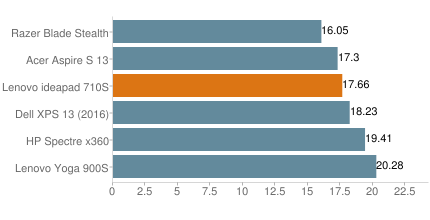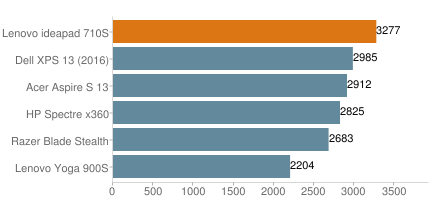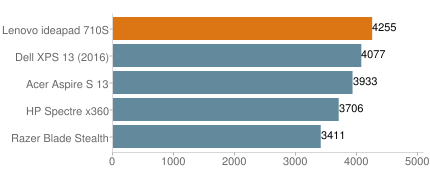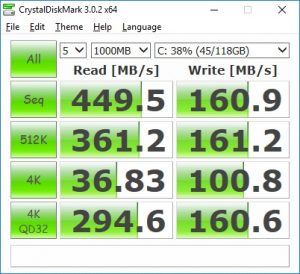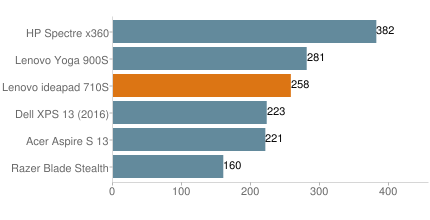Lenovo ideapad 710S Review: A High-Value Ultrabook.
The ideapad 710S is a new premium Ultrabook from Lenovo. It features a classy magnesium-aluminum construction, a near bezel-less display, and is just 2.6 pounds and 0.55 inches thin. On the inside, it packs Intel's latest "Skylake" Core i-series processors, up to 16GB of RAM, and PCI-express SSD storage. We gave this sleek beauty high marks for just about everything, minus some keyboard layout quibbles, and its subpar selection of ports.
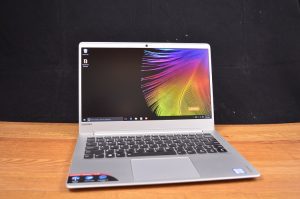
Lenovo ideapad 710S
We initially thought the ideapad 710S was plastic when we took it out of the box. It's lighter than the average 13.3-inch notebook, at 2.6 pounds. This puts it just slightly under the Dell XPS 13 (2016), and the Acer Aspire S 13, two of its closest competitors. Rather than plastic, however, the all-silver ideapad 710S uses magnesium and aluminum. This helps keep the weight down, and also strengthens the chassis. Indeed, the base of the notebook is rigid, with just a bit of side-to-side play when we torqued it by its corners (which you should avoid doing, by the way). The lid has a bit of flex to it, but actually provides excellent protection to the display panel. We weren't able to get ripples to appear in the display by pressing in on the back of the lid. This is even more impressive in view of the lid's thinness. Another impressive fact about the lid is that it tilts 90 degrees past vertical, allowing it to lay completely flat with the surface. This is unusual, as most not ebooks tend to stop around the 45 degree mark, or shortly thereafter. The lid's hinge is a bit too stiff to allow it to be opened one-handed, though.
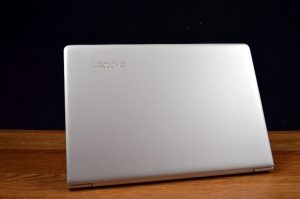
Input and Output Ports
Port selection isn't one of the strong points for the ideapad 710S. The left edge has a traditional AC power jack, USB-A 3.0, the audio combo jack, and a pin-sized reset button. The right side has the power indicator LED, full-size SD card reader, a powered USB-A 3.0, and micro HDMI. We'd have appreciated if USB-C was included. Furthermore, we'd prefer to see a full-size video out. It does look like a full-size HDMI port would have fit where the micro version resides. Chances are, you'll need to get a micro HDMI to HDMI adapter to make use of the port, in most situations (about $5-10 online). While we're glad to see the full-size SD card slot, as opposed to the increasingly common micro SD, the SD cards stick halfway out of the slot. This means you'll have to take the SD card out prior to transporting the notebook. As a final complaint, the ideapad 710S lacks a lock slot. We'd like to see one, as we imagine the extra-portable nature of this notebook will make it popu lar with college students and frequent travelers.
For wireless connectivity, the ideapad 710S includes Intel's top-of-the-line Dual Band Wireless-AC 8260 wireless card, with a 2×2 antenna setup. It also has internal Bluetooth 4.0. We experienced no connectivity issues during our testing.
Screen and Speakers
One screen is offered on the ideapad 710S. It's a 13.3-inch panel, with an anti-glare surface, and a full HD resolution (1,920×1,080 pixels). The screen is a definite selling point for this notebook, as the picture quality is outstanding. The brightness is high enough that it can be used outdoors on a sunny day. The anti-glare surface makes it even more practical outdoors, as it nixes the reflections from surrounding light sources. The color reproduction is good, too, though Lenovo doesn't publish the exact color gamut coverage. Moreover, the contrast is very good, with stark whites and deep blacks.
The panel's full HD resolution is usable without increasing the text size via Windows scaling. Our review unit arrived with the scaling set to 150 percent, however, which made everything seem a bit too large to our eyes. (It was easy enough to change in Windows display settings.) This resolution is excellent for work and play. Two windows can be arranged side-by-side with minimal resizing, and you can stream full HD videos in perfect clarity. It's an ideal resolution for a screen this size.
All that's missing from this display is touch, which isn't offered on any model. It's not a huge deal, considering the ideapad 710S isn't a convertible. Take a look at Lenovo's excellent Yoga 900S if you're interested in the convertible functionality.
JBL speakers are built into the chassis. They project downward under either side of the palm rest. We weren't expecting much, given the thin chassis, but were proven wrong. The ideapad 710S has admirable sound quality for a notebook. It's full and reasonably loud, enough to entertain two people sitting around a table. It's distortion free, as far as we could tell, all the way up to maximum volume. Lastly, there's even an audible amount of bass. Some of the sound quality is dependent on the notebook sitting on a solid surface, which it uses to project sound. It tends to sound muffled in your lap, for example.
 Keyboard and Touchpad
Keyboard and Touchpad
The ideapad 710S's full-size Chiclet keyboard has two brightness levels (toggled by pressing the Fn key plus the space bar), plus completely off. The layout is mostly as expected, with two exceptions. The first is that the power button is part of the keyboard. It's at the upper right corner, just above the Backspace key. We've seen this practice from Asus as well, on certain models, and it leaves us wishing the power button were its own, dedicated key. On the plus side, it's tough to accidentally trigger because it only puts the system to sleep after being held down for two full seconds. Note that the power indicator LED isn't part of the power button. Rather, it's on the right edge of the chassis.
The second exception to the otherwise-acceptable keyboard layout is the arrow key cluster. It's forced to live in the main keyboard area, instead of being slightly divorced downward. This arrangement causes it to displace the right Shift key, which now resides next to the Up arrow, one-third sized. Naturally, this can take adjustment if you're used to using right Shift. We're a bit more forgiving about the fact that the Home, End, PgUp, and PgDn keys are embedded as Fn-key combos in the arrow key cluster, as the keyboard spans nearly the entire width of the chassis. There didn't appear to be room for them to exist as dedicated keys.

The Lenovo's amply oversized touchpad is centered in the palm rest. It's of the clickable variety, where you press down anywhere to click. Its anti-glare surface permits smooth finger tracking, though the clicks took a tad more effort than we expected. They also required progressively more pressure as we approached the top of the pad. In a positive move, we liked how the right-click zone was rather well defined. Pressing on or to the right of the orange line at the bottom of the pad is a right click; everywhere else is a left click. We were also pleased to find that the click sounds were relatively muted.
We're reviewing the base configuration of the Lenovo ideapad 710S, which goes for $749.99. The heart of this notebook is an Intel "Skylake" Core i5-6200U processor. It has two processing cores running at 2.3GHz, with a Turbo Boost dynamic frequency up to 2.8GHz (thermal and power conditions permitting). It has considerably stronger performance than the Intel Core M processors commonly found in tablets like the Lenovo ThinkPad X1 Tablet, and very low-profile notebooks. As of writing, the ideapad 710S was also offered with a Core i7-6560U dual-core processor. Despite being the more expensive option, it actually runs a bit slower than the i5-6200U in its base clock, at 2.2GHz, but the draw for the i7-6560U is its significantly upgraded Iris Graphics 540. The Core i5-6200U has just the Intel HD 520 graphics. Ideapad 710S models with the i7-6560U start at $1,199.99, which is quite the uptick in price from the base model. We're not sure it's worth the extra money, as even with the Iris Graphics 540, the ideapad 710S still isn't close to fast enough to run today's AAA gaming titles (as our benchmarks will show shortly).
The 128GB of storage in the base ideapad 710S is on the low side, by 2016 standards. Only about 91GB was free on our review sample, after formatting and the Windows 10 install. We'd like to see 256GB of space at the minimum. We'd also like to see better performance from the drive. Although the Samsung model in our ideapad 710S used the new PCI-express interface, it wasn't particularly fast. Our benchmarks showed just 460MB/s read, and just 161MB/s write. Most high-end SATA III drives, like the Kingston HyperX Savage and PNY CS2211 are faster, especially in write performance. But unless you're frequently copying or reading files that are several hundred MB or more in size, you'd be unlikely to notice the difference between a fast and a slow SSD. The reality is that a "slow" SSD is still far faster than a traditional hard drive.
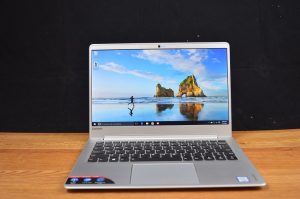
The 8GB of LPDDR3-1866 RAM in the base ideapad 710S is sufficient for all but the most demanding of tasks. Lenovo did offer this model with 16GB of RAM in its top-end configuration, as of writing, which also included a 512GB SSD, and the mentioned Core i7-6560U processor. It was almost twice the price of the base configuration at $1,399, making it a very expensive upgrade. But it's a price you'll have to consider if you want 16GB of RAM. The ideapad 710S's memory is permanently soldered to the motherboard, making aftermarket upgrades a no-go. The CPU is also soldered and therefore non-upgradeable. On the other hand, the storage drive is upgradeable. Removing the nine screws on the bottom of the chassis, and gently prying off the cover rewards you with access to the single M.2 2280 slot.
In terms of software, our ideapad 710S arrived with a mostly clean installation of Windows 10. The usual collection of Windows 10 apps and a Microsoft Office trial were also installed. The only actual piece of bloatware was a McAfee LiveSafe trial, which took just a couple of minutes to uninstall.
Our Lenovo ideapad 710S review unit had the following configuration:
- 13.3-inch non-touch display (1,920×1,080 resolution, anti-glare surface, IPS panel)
- Windows 10 Home 64-bit
- Intel Core i5-6200U dual-core processor (2.3GHz, up to 2.8GHz Turbo Boost, 3MB cache, 15W TDP)
- Intel HD 520 integrated graphics
- 8GB LPDDR3-1600 dual-channel RAM (non-upgradeable)
- 128GB M.2 PCI-e SSD (SAMSUNG MZNLN128HCGR)
- Intel Dual Band Wireless-AC 8260 wireless network adapter
- Internal Bluetooth 4.0
- Built-in 720p webcam
- Dimensions: 12.1 x 8.4 x 0.55 inches
- Weight: 2.6 pounds
- 1-year limited warranty
- Starting Price: $749.99
- Price as configured: $749.99
Benchmarks
wPrime processor comparison results (listed in seconds – lower scores mean better performance):
PCMark8 Home (Accelerated) measures overall system performance in Windows 8 for general activities from web browsing and video streaming to typing documents and playing games (higher scores mean better performance):
PCMark8 Work (Accelerated) measures overall system performance in Windows 8 for work-related productivity tasks (higher scores mean better performance):
CrystalDiskMark storage drive performance test:
Heat and Noise
The ideapad 710S actually has two cooling fans, one on either side of the chassis. The processor is located between them, and the heatsinks coming off the processor are routed to the fans. This setup allows the thermal load to be spread out further, reducing heat buildup in one spot. The fan exhausts, aimed out the back of the chassis, flow air over the display hinge and the display lid. An intake is in between the fan exhausts, though the fans also get their air from a perforated grate under the notebook.
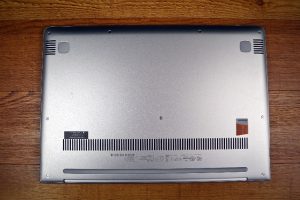
The fans generally remains off for casual usage, like word processing and light web surfing. They run at a low speed while streaming a video. We only noticed them operating at top speed while running our benchmark suite. Even at top speed, though, they're still relatively quiet. There was surprisingly no fan whine.
Battery Life
We clocked the ideapad 710S at four hours, 20 minutes in our demanding Powermark battery life test. This is a far more demanding test than a typical rundown, with a combination of automated web browsing, office productivity, and 3D gaming workloads. We run the test at approximately 50 percent display brightness.
Powermark battery life test results listed in minutes (higher scores mean better battery life):
The Dell XPS 13 (2016) only managed 3 hours, 55 minutes in this test, while the Acer Aspire S 13 an even lesser 3 hours, 41 minutes. Note these times are worst-case. For general usage in real life, you can expect to get runtimes upwards of 20-30 percent higher than these numbers, especially if you keep the screen brightness low. In the ideapad 710S's case, that would mean enough life to span an entire workday.
Power Adapter
The ideapad 710S ships with a 45W power adapter. It's slightly different than the typical power brick setup, with the two-prong plug built into the power brick. This design can take up two outlets. The cable can't be detached from the brick.
On the plus side, the power adapter is very light at just 5.7 ounces, including the cables. We were hoping for a bit longer reach; including the length of the adapter itself, the furthest away you could get from an outlet is 6 feet, 6 inches.

From its sleek magnesium-aluminum construction, to its beautiful IPS anti-glare display, the ideapad 710S is a highly practical mobile device. It's a featherweight at just 2.6 pounds, and is just 0.55 inches thin. Its slim display bezel helps it be dimensionally smaller than a typical 13.3-inch notebook.
This ideapad 710S outpaces its two main rivals in battery life, the Dell XPS 13 (2016) and Acer Aspire S 13, with enough stamina to last a full workday. We furthermore noted its comfortable keyboard, touchpad, and even that it has a very good set of JBL speakers.
We were primarily let down by the substandard port selection. This Ultrabook has no USB-C, and the only video out is micro HDMI, for which you'll likely need to invest in an adapter. SD cards don't insert fully into its reader, either. We'd furthermore like to see the power button as a dedicated button, instead of a keyboard key. Lastly, it'd be nice to have a touch display option. (It was not offered at the time of writing.)
We thought the 128GB storage drive in our $749.99 review model was on the low side, for capacity; we'd like to see at least 256GB at this price point. Otherwise, we were satisfied with the performance from the ideapad 710S's Intel Core i5-6200U processor and 8GB of RAM. Upper-tier configurations were quite expensive, with the flagship model commanding $1,399 for a Core i7-6560U processor, 16GB of RAM, and a 512GB SSD. We think the best value is in the base model we reviewed.
Overall, the Lenovo ideapad 710S is a diamond in the rough, and it earned a well-deserved Editor's Choice.

Lenovo ideapad 710S
Pros:
- Beautifully thin metal design
- Excellent quality IPS, anti-glare display
- Great battery life
- Quiet cooling fans
- Solid-sounding speakers
Cons:
- Minimal port selection, and no USB-C
- Keyboard layout quibbles
- Top-tier configurations are pricey
- Touch display not offered
Source: www.bing.com
Images credited to www.bing.com and www.notebookcheck.pl
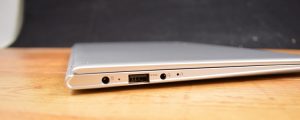
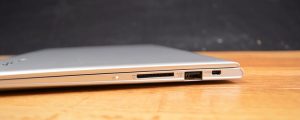

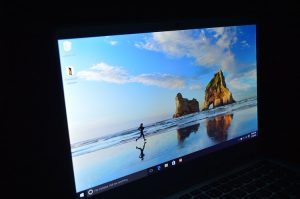

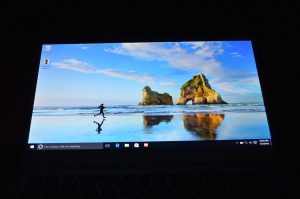
 Keyboard and Touchpad
Keyboard and Touchpad